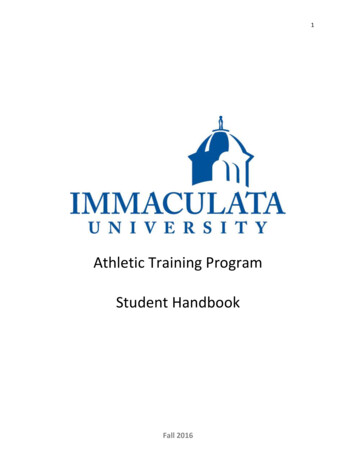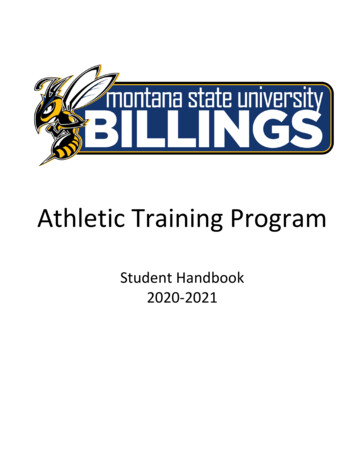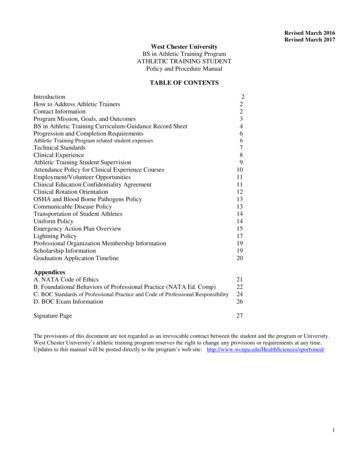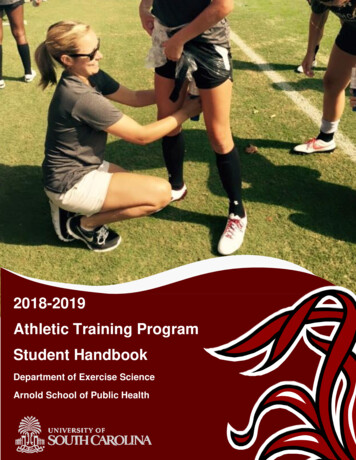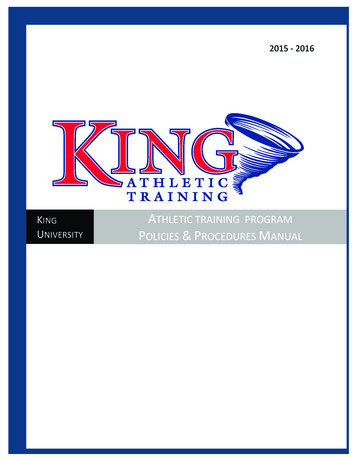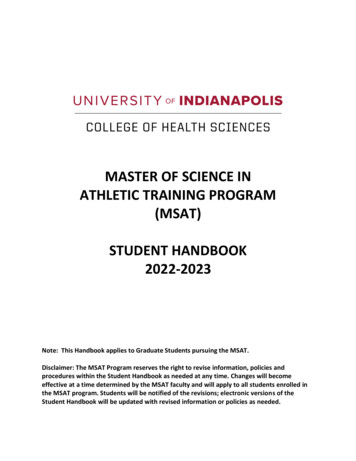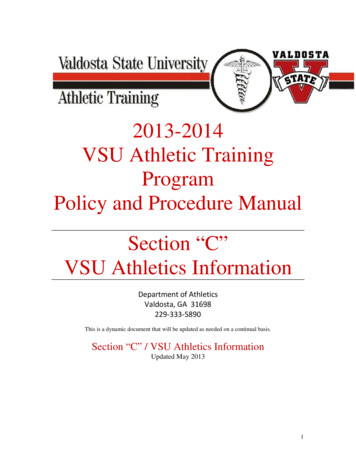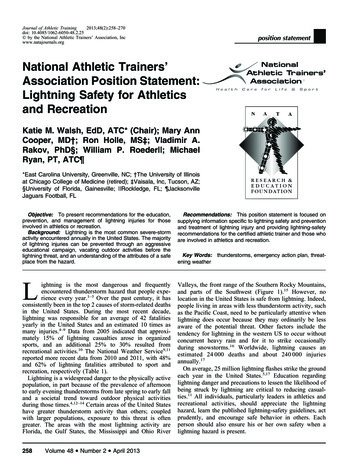
Transcription
Journal of Athletic Training2013;48(2):258–270doi: 10.4085/1062-6050-48.2.25Ó by the National Athletic Trainers’ Association, Incwww.natajournals.orgposition statementNational Athletic Trainers’Association Position Statement:Lightning Safety for Athleticsand RecreationKatie M. Walsh, EdD, ATC* (Chair); Mary AnnCooper, MD†; Ron Holle, MS‡; Vladimir A.Rakov, PhD§; William P. Roeder ; MichaelRyan, PT, ATC¶*East Carolina University, Greenville, NC; †The University of Illinoisat Chicago College of Medicine (retired); ‡Vaisala, Inc, Tucson, AZ;§University of Florida, Gainesville; Rockledge, FL; ¶JacksonvilleJaguars Football, FLObjective: To present recommendations for the education,prevention, and management of lightning injuries for thoseinvolved in athletics or recreation.Background: Lightning is the most common severe-stormactivity encountered annually in the United States. The majorityof lightning injuries can be prevented through an aggressiveeducational campaign, vacating outdoor activities before thelightning threat, and an understanding of the attributes of a safeplace from the hazard.Lightning is the most dangerous and frequentlyencountered thunderstorm hazard that people experience every year.1–3 Over the past century, it hasconsistently been in the top 2 causes of storm-related deathsin the United States. During the most recent decade,lightning was responsible for an average of 42 fatalitiesyearly in the United States and an estimated 10 times asmany injuries.4–9 Data from 2005 indicated that approximately 15% of lightning casualties arose in organizedsports, and an additional 25% to 30% resulted fromrecreational activities.10 The National Weather Service9,11reported more recent data from 2010 and 2011, with 48%and 62% of lightning fatalities attributed to sport andrecreation, respectively (Table 1).Lightning is a widespread danger to the physically activepopulation, in part because of the prevalence of afternoonto early evening thunderstorms from late spring to early falland a societal trend toward outdoor physical activitiesduring those times.4,12–14 Certain areas of the United Stateshave greater thunderstorm activity than others; coupledwith larger populations, exposure to this threat is oftengreater. The areas with the most lightning activity areFlorida, the Gulf States, the Mississippi and Ohio River258Volume 48 Number 2 April 2013Recommendations: This position statement is focused onsupplying information specific to lightning safety and preventionand treatment of lightning injury and providing lightning-safetyrecommendations for the certified athletic trainer and those whoare involved in athletics and recreation.Key Words:ening weatherthunderstorms, emergency action plan, threat-Valleys, the front range of the Southern Rocky Mountains,and parts of the Southwest (Figure 1).15 However, nolocation in the United States is safe from lightning. Indeed,people living in areas with less thunderstorm activity, suchas the Pacific Coast, need to be particularly attentive whenlightning does occur because they may ordinarily be lessaware of the potential threat. Other factors include thetendency for lightning in the western US to occur withoutconcurrent heavy rain and for it to strike occasionallyduring snowstorms.16 Worldwide, lightning causes anestimated 24 000 deaths and about 240 000 injuriesannually.17On average, 25 million lightning flashes strike the groundeach year in the United States.5,17 Education regardinglightning danger and precautions to lessen the likelihood ofbeing struck by lightning are critical to reducing casualties.11 All individuals, particularly leaders in athletics andrecreational activities, should appreciate the lightninghazard, learn the published lightning-safety guidelines, actprudently, and encourage safe behavior in others. Eachperson should also ensure his or her own safety when alightning hazard is present.
Table 1. US Lightning Fatalities, 2006–2011aYear200620072008200920102011Total, 2006–2011babThe plan should have the following components:Victims WhoVictims Engaged Sought ShelterTotalin Recreation,Under or NearFatalities, No.No. (%)a Tree, No. Data from National Weather Service: .Totals do not sum to 100 because of rounding.The purpose of this position statement is to encourageproper lightning-safety policies and to educate athletictrainers and others involved with athletic or recreationalactivities about the hazards of lightning so they can beproactive in preventing lightning-related trauma. Thefollowing recommendations are based on the most recentupdates in lightning safety. The evidence categories adhereto the American Family Physician’s Strength of Recommendation Taxonomy (SORT) for grading evidence in themedical literature.18RECOMMENDATIONSEstablish a Lightning-Specific Emergency ActionPlanFormalize and implement a comprehensive proactiveemergency action plan (EAP) specific to lightning safetyfor each venue.1–3,13,19–22 Evidence category: C1. Promote lightning-safety slogans supported by the NationalWeather Service.11a. ‘‘NO Place Outside Is Safe When Thunderstorms Are InThe Area!’’b. ‘‘When Thunder Roars, Go Indoors!’’c. ‘‘Half An Hour Since Thunder Roars, Now It’s Safe ToGo Outdoors!’’2. Establish a chain of command that identifies a specificperson (or role) who is to make the decision to removeindividuals from the field or activity. This person musthave recognized and unchallengeable authority to suspendactivity.13,19 Evidence category: C3. Use a reliable means of monitoring the local weather.Before the event, identify a specific person (a weatherwatcher) who is responsible for actively looking forthreatening weather and is charged with notifying thechain of command.13,19,23 Evidence category: C4. Identify safe locations from the lightning hazard inadvance of the event for each venue.13,19,23 Evidencecategory: C5. Identify specific criteria for suspending and resumingactivity in the EAP.13,23 Evidence category: CLightning and General Weather Awareness6. Use a designated weather watcher and the NationalWeather Service to monitor local weather.13,19 Evidencecategory: C7. Consider subscribing to a commercial, real-time lightningdetection service that has been independently and objectively verified.24–28 Evidence category: CFigure 1. Lightning flash density, 2007–2011. National Lightning Detection Network. This map portrays the regions of highest cloud-toground lightning strikes (Florida and the Southeast) and the areas with the least frequent strikes (the West Coast and Western states). ÓVaisala 2012. Reprinted with permission.Journal of Athletic Training259
Identify Locations Safe from Lightning8. For each venue, identify substantial, fully enclosedbuildings with wiring and plumbing, such as a school,field house, library, home, or similar habitable (eg, wherepeople live and work) building to serve as a safe placefrom lightning. Identify these locations before the event,and inform participants of them. Access to these buildingsduring outdoor activities must be assured.13,14,19,22,23,29,30Evidence category: A9. Fully enclosed metal vehicles such as school buses, cars,and vans are also safe locations for evacuation.13,19,23,30,31Evidence category: ATable 2. Weather Terms Defined by the National Oceanic andAtmospheric Administration’s National Weather Service (www.weather.gov)TermDefinitionWatchIssued when the risk of a hazardous weatherevent is significantly increased, but itspresence, location, or timing is unclear; thepurpose is to provide enough time to set plansin motion.Issued when hazardous weather (ie, conditionsposing a threat to life or property) is occurring,is imminent, or has a very high probability ofoccurring.Length measurement relating to 1 min of arc oflatitude along any meridian; equal to 1.852 km,1.150779 statute mi, or 6076 ft; commonmeasurement used by navigators, aviators, andareas associated with international law.Wind speed measurement over 1 nautical mi/h;equal to 1.85 km/h or 1.15 m/h.WarningNautical mile (M,NM, or nmi)Identify Locations Unsafe from Lightning10. Unsafe locations include most places termed shelters,such as picnic, park, sun, bus, and rain nonmetal sheltersand storage sheds.10,13,15,29,32 Evidence category: A11. Locations with open areas, such as tents, dugouts,refreshment stands, gazebos, screened porches, pressboxes, and open garages are not safe from a lightninghazard.13,33,34 Evidence category: A12. Tall objects (eg, trees, poles and towers, and elevatedareas) are potential lightning targets and should beavoided. Large bodies of water, including swimmingpools, are unsafe areas.19,32,33 Evidence category: A13. Injuries have been reported to people inside a buildingwho were using plumbing or wiring or were near enoughto the structure to receive a side flash from lightning.Close proximity to showers, sinks, locker rooms, indoorpools, appliances, and electronics can be unsafe.1,2,14,22,32,35,36 Evidence category: ACriteria for Postponement and Resumption ofActivities14. Postpone or suspend activities if a thunderstorm appearsimminent before or during activity. Watch the skies forlocally developing or approaching storms that have notyet produced lightning.1,13,37 Evidence category: A15. All individuals must be completely within an identifiedsafe location when thunderstorms are already producinglightning and approaching the immediate location andwhen the distance between the edge of the lightning stormand the location of the outdoor activity reaches 5 nauticalmiles (nmi; roughly 6 statute miles or 9.26 km; Table2).14,19,22,38–40 Evidence category: C16. Allowing time for individuals to evacuate the premises,leave outdoor facilities, and be completely within thedesignated safe location(s) must be taken into consideration in the lightning-safety plan.1,13,20 Evidence category: C17. Activities should be suspended until 30 minutes after thelast strike of lightning is seen (or at least 5 nmi away) andafter the last sound of thunder is heard. This 30-minuteclock restarts for each lightning flash within 5 nmi andeach time thunder is heard. Consideration must be givento patrons leaving safe locations and returning to thevenue.13 Evidence category: A260Volume 48 Number 2 April 2013KnotLarge-Venue Planning18. A specific lightning-safety plan for large-scale eventsshould be established and include the components of theEAP for lightning. The National Oceanic and Atmospheric Administration (NOAA) has a tool kit thatprovides direction for large-venue lightning safety.41The plan should include the following items20:a. Use of a reliable weather-monitoring system todetermine whether to cancel or postpone activity beforethe event begins. Continuous monitoring of the weathershould occur during the event.b. Means to prevent spectators from entering an outdoorvenue when the event is suspended due to lightning.Spectators should be directed to the nearest safelocation.c. Identification of enough close-proximity substantialbuildings and vacant, fully enclosed metal vehicles tohold all individuals affected by the lightning hazard,including participants and spectators.d. Means to ensure a safe and orderly evacuation from theevent, including announcements, signage, safety information in event programs and brochures, assistancefrom ushers, and entrances that also serve as exits.e. Consideration for the time it takes to notify and move allindividuals so they can be wholly within a safe,substantial building by the time the leading edge ofthe storm is within 5 nmi of the outdoor activity.22,38Evidence category: CFirst Aid19. Active thunderstorms can pose an ongoing hazard torescuers as well as spectators and sport participants.Rescuers and emergency personnel must ensure their ownpersonal safety before venturing into the venue to provideaid.35,42–44 Evidence category: A20. Activate the emergency management system. Evaluateand treat patients in the following order: (a) Movepatient(s) carefully to a safer location if needed. (b)Evaluate and treat for apnea (cessation of breathing) andabsence of heartbeat (cardiac arrest). (c) Assess level ofconsciousness. (d) Evaluate and treat for the possibility of
spinal injuries. (e) Evaluate and treat for hypothermia.13,35,42 Evidence category: A21. Personnel responsible for the well-being of participantsshould maintain current cardiopulmonary resuscitation(CPR) and first-aid certifications.19 Evidence category: C22. If an automated external defibrillator (AED) is available, it should be applied on anyone who appears to beunconscious, pulseless, or apneic. However, other firstaid efforts and resuscitation should not be delayed whilean AED is being located.13 Evidence category: APersonal Safety and Notification of Participants ofLightning Danger23. If thunder can be heard, lightning is close enough to be ahazard, and people should go to a safe locationimmediately.1,11,37 Evidence category: A24. In the event of impending thunderstorms, those in controlof outdoor events should fulfill their obligation to warnparticipants and guests of the lightning danger.13,20Evidence category: C25. All individuals have the right to vacate an outdoor site orunsafe area, without fear of repercussion or penalty, inorder to seek a lightning-safe location if they feel indanger from impending lightning activity. Evidencecategory: CBACKGROUNDLightning-Flash DevelopmentLightning can be defined as a transient, high-current(typically tens of kiloamperes) electric discharge in the airwith a length measured in kilometers. The lightningchannel is composed of ionized gas (plasma) that carriesa peak temperature around 50 0008F (27 7608C), about 5times greater than the temperature of the surface of thesun.45 The 2 primary types of lightning are cloud-to-groundand in cloud. This article focuses on cloud-to-groundlightning because that is the source of lightning casualties.A cloud-to-ground lightning flash is the product of thebuildup of positively and negatively charged regions in thecloud. The resultant electrical potential gradients initiatethe lightning flash that typically begins from a negativelycharged region of the cloud as a stepped leader that movesin a series of steps toward the ground. The stepped leadercreates a conducting path between the cloud source and theground and distributes negative charge along this path.Various objects on the ground (trees, chimneys, umbrellas,people, etc) can produce positively charged, upwardleaders. The upward leader rises from the ground andmeets the descending stepped leader. The connection of thestepped leader with an upward leader determines thelightning-channel termination point on the ground.45After contact, a bright return stroke propagates upwardfrom the ground, while electrons move downward towardthe earth.14,45 This return stroke rapidly heats the lightningchannel, causing it to illuminate and quickly expand tocreate visible lightning and audible thunder. One or moresubsequent downward leaders can retrace the channel. Eachof these leaders results in its own upward return stroke thatreilluminates the channel. A negative cloud-to-groundlightning flash is the most common polarity of lightningand has an average of 3 to 5 return strokes per flash. Thetime between return strokes and corresponding reilluminations of the lightning channel is a few hundredths of asecond, which is near the limit of human perception andexplains why lightning appears to flicker.45On average, more than 90% of global cloud-to-groundlightning is negative (negative charge is effectivelytransported to the ground). Positive lightning dischargesare much less common than negative and are more likely tohave fewer strokes. Positive lightning is more energetic andpotentially more destructive than negative lightningbecause it often involves long, continuing current.45 Theentire flash lasts less than a second, but a large amount ofenergy is transferred to the earth from the cloud.Lightning is essentially a large electric spark, similar tothat received from touching a doorknob after walkingacross a carpeted room in dry weather. Yet the charge ismuch greater, which allows it to cross the thick insulatingair barrier between the cloud and ground. Cloud-to-groundlightning flashes have an average peak current of 30 000amperes (A), with a range from approximately 5000 tomore than 200 000 A, and the electrical potential betweenthe cloud and ground can be 50 million to 500 millionV.14,45 The lightning channel is approximately 1 in (2.5 cm)in diameter and averages 3 to 5 mi (4.83 to 8.05 km)long.14,45 Although most (90%) cloud-to-ground lightningstrikes within the area of rain falling on the ground, theremaining 10% typically occurs as far as 5 to 10 mi (8 to 16km) away from the edge of the rainy area.14 Under certainconditions, lightning may strike tens of miles from theparent thunderstorm.It is the intense optical radiation from the heated air thatwe see as lightning. This rapid heating also creates achannel pressure of 10 atm or more, resulting in suddenchannel expansion and an outward-propagating shock wavethat eventually becomes the thunder heard at a distance.45Although it is possible to see lightning without hearing itsthunder, thunder never occurs in the absence of lightning.The audible range of thunder is about 10 mi (16 km) butcan be more or less depending on local conditions.22Lightning-Casualty DemographicsDespite lightning being widely recognized as a severeweather hazard, injuries are underreported. There is nolegal requirement for reporting these types of injuries ordeaths, and many survivors do not seek immediate medicalattention after a lightning incident unless they are severelyinjured.4Approximately 90% of lightning casualties occur fromMay to September; July has the greatest number ofvictims.4,6,12,14,46 Furthermore, 45% of the deaths and80% of the casualties occurred in these months between10:00 AM and 7:00 PM,4,6,12,15,46 which coincides with themost likely time for athletic or recreational events. Thestatistics on lightning-casualty demographics compiledfrom the NOAA publication Storm Data for Colorado overthe last few decades demonstrate an increase in thepercentage of lightning casualties in persons involved insports and outdoor recreation.3,5,12,34 In addition, the highestnumber of casualties from lightning for each year of thestudy was recorded in recreational and sports activities.15,47Journal of Athletic Training261
Lightning-casualty statistics from the National WeatherService (NWS) for 2006–2011 demonstrate that the mostcommon sites for fatalities were under or near trees (25%),open or sports fields (25%), close to water (23%), and in theyard (10%).9 Of the fatalities, 95% occurred outdoors, andthe remaining deaths were in unsafe shelters that did notprotect people from lightning.11 Most of these deathsoccurred within a short distance of a safe location whenpeople chose to continue their activity, were oblivious tothe lightning threat, or resumed activity too soon afterhaving initially sought safety in a substantial building.9Epidemiologic studies reviewing occupational deathsfollow the same trend as the data from Storm Data. Ofthe deaths due to lightning from 1995–2000, 75% occurredin the South and Midwest, with Florida and Texas reportingthe greatest number of fatalities. Agriculture and construction venues accounted for the largest number of occupationrelated fatalities due to lightning.48,49 Military reportsparallel findings from Storm Data: 75% of injuries tomilitary personnel from lightning occurred between Mayand September, with 50% in July and August. The majorityof incidents (87%) involved injury to more than 1 person,with a single strike resulting in 44 casualties during anoutdoor training exercise.50Population density and building or housing conditionsalso play important roles in casualty demographics.29,51Improvements in building construction and the widespreadavailability of fully enclosed, metal-topped vehicles sincethe 1900s have reduced the number of casualties.29,31,43 Theheight of an object and its isolation significantly increasestrike probability.22,32,52Mechanism of Lightning InjuryLightning injury or death can occur via 6 mechanisms:direct strike, contact injury, side flash, step voltage, upwardleader, and concussive injury (Figure 2).14,43,53 Safetyplanning should take into account all of these possiblemechanisms before appropriate locations for waiting outthe storm are identified.A direct strike is the least common mechanism (up to 5%of all reported lightning injuries54) and is often inaccuratelyperceived as the most important aspect to consider in safetyrecommendations. A direct strike occurs when a lightningbolt hits the victim without striking anything else beforecontact.Contact injury occurs when the lightning victim istouching an object that is in the pathway of the lightningcurrent, such as a fence, indoor plumbing, hard-wiredtelephone, bleacher, or computer game.43 Contact injury isresponsible for 3% to 5% of all lightning trauma.54Side flash, or splash, occurs when lightning strikes anobject near the victim and a portion of the energy jumpsfrom that object to the victim. Examples include the treeunder which a person has sought shelter, beneath an openstadium, or in a dugout. Approximately 30% to 35% ofreported lightning injuries are due to the side-flashmechanism.54Step voltage, or ground surface arc, occurs when anindividual near the strike intercepts a portion of thelightning current that flows radially outward from theground strike. If one of the individual’s feet is closer to thestrike than the other, a step voltage is created between the262Volume 48 Number 2 April 2013Figure 2. Lightning deaths by lightning mechanism. Blunt injurycontribution is unknown. Reprinted with permission.54feet.43,55 A portion of the current travels up the leg closer tothe ground strike and down the farther leg to continue itsmovement in the ground. Step voltage is by far the mostcommon mechanism of lightning injury, responsible for atleast half of all lightning-related injuries and deaths.54 Thismechanism and side flash are especially dangerous whenlarge numbers of people are gathered, such as during anathletic event, and lightning hits the playing field or aparticipant.An upward leader is a lightning channel developing fromthe earth toward the cloud and is probably responsible for10% to 15% of all lightning trauma.53,54 Multiple upwardleaders are produced by thunderstorms and may go throughpeople standing in the area of the storm. Even when adownward leader from the cloud attaches to an upwardleader from the ground to complete a cloud-to-groundstrike, other upward leaders that remain unconnected cancarry sufficient energy to injure or kill.Concussive, or blunt, injury results when lightningcurrent causes violent muscular contractions, throwingvictims many meters from the strike point. Explosive andimplosive forces created by the rapid heating and cooling ofthe lightning current are also enough to produce traumaticinjuries similar to being close to a grenade without theshrapnel.43,55–57 Concussive eye and ear injuries arecommonly reported in the literature; less common arecontusions to the lung, brain, and other tissues.43,57–59Common Effects of Lightning on HumansLightning has several direct effects on human systems:cardiovascular, neurologic, and sensory organs. Yet aperson may also sustain indirect injury via fire, fallingobjects, and its explosive nature.60 Although the only acutecause of death is cardiac arrest,42 the anoxic brain damagethat may occur during delayed or prolonged resuscitationcan be devastating. The survivor who does not sustain acardiac arrest may have permanent sequelae, includingbrain-injury symptoms such as short-term memory problems, attention deficit, difficulty processing new informa-
tion, and severe and ongoing headaches.61,62 Long-terminjuries may appear soon after the lightning strike or takemonths to develop.35,61,63,64 Some patients develop chronicpain syndromes or absence-type seizures. Other frequentlyreported results of lightning are superficial burns, ocularand tympanic membrane damage, and psychological andcognitive dysfunction.43,44,58,59 Superficial burns occur infewer than 30% of patients and are more often associatedwith metal on clothing or jewelry that is heated by thecontact with lightning.44 Tympanic membrane ruptureshave been reported in many patients and may be associatedwith the concussive nature of the lightning strike.43,44,58,59Some survivors are unable to return to their previouslevel of function. They may become incapable ofcontinuing in their current jobs or educational pursuitsand may be permanently disabled. Depression and suicidalthoughts are very common, as are postconcussive symptoms.65 Survivors may benefit from a support network, suchas Lightning Strike and Electric Shock Survivors International, Inc (http://www.lightning-strike.org).61,66,67Two unique transient signs of lightning strikes arekeraunoparalysis and the pathognomonic but rare signbetter known as the Lichtenberg figure. The former consistsof limb weakness or paralysis, pallor, and diminishedpulses that commonly occur after a lightning strike butusually resolve in a period of hours. The latter involves afeathering or serpentine surface dermatologic marking,which usually resolves over a period of hours todays.61,65,67,68 Recognizing the possibility of keraunoparalysis is critical when assessing patients for adequatecardiovascular circulation. Rescuers should check both coreand distal pulses to ensure accurate circulatory status.First Aid for Lightning VictimsA common myth is that lightning victims carry theelectrical charge from the lightning strike, which canelectrocute someone who touches them. Unlike exposure toelectrical power with a downed line that can be dangerousto both the victim and rescuers, lightning is so short livedthat no charge remains even 1 millisecond after the strike.Touching a lightning victim to provide first aid is safe.64However, it should be noted that rescuers are at risk oflightning injury if active thunderstorms continue in thearea. Athletic trainers and all rescuers should consider theirown personal safety before venturing into a dangeroussituation to render care. The EMS should be activated assoon as it is determined that casualties may exist.Sometimes it is best to evacuate the patient to a safer areabefore beginning first-aid and resuscitation efforts. Movinga victim to an area of greater safety for resuscitation isunlikely to cause any serious musculoskeletal injury to thepatient.43 Primary and secondary assessments of thevictim’s condition can be conducted once a safe locationis reached. An additional potential danger is power linesthat have come down. If there is any indication that thepatient was injured by power lines, rescuers should nottouch him or her until the scene has been secured.Although the long-term sequelae can be quite profound,the mortality rate for lightning-strike victims is only about8% to 10%.35 Most lightning deaths are due to cardiac orrespiratory arrest at the time of injury; very rarely is a fallfrom a height sufficient to cause death. If a lightning-strikevictim presents in asystole cardiac or respiratory arrest, it iscritical to initiate CPR as soon as safely possible.42,69 It isnot uncommon to find a lightning victim unconscious, withcold extremities and in cardiopulmonary arrest.23,35,42 Thebasic principle of triage, ‘‘treat the living first,’’ should bereversed in patients struck by lightning. Those who appearto be dead should be treated first.42,70 All the others who aremoving and breathing will live, and even though some maysustain permanent sequelae, delaying care will not worsentheir conditions.If an AED is available, it should be used with victimswho are unconscious or may be in cardiac arrest. Ifventricular fibrillation is detected, the AED will apply anelectrical charge that actually stops the disordered heartbeatand allows the cardiac muscle to start contracting. If thecardiac rhythm detected is not fibrillation, the AED will notfire and CPR should be restarted. Automated externaldefibrillators should be readily available for use withlightning victims and in other first-aid situations wherelarge numbers of people are at risk. However, CPR andother care should not be delayed while an AED is beinglocated.44Surprisingly few lightning survivors need to be admittedto the hospital, although they should preferably be screenedthere. Some survivors exhibit signs of concussion ortraumatic brain injury, with anterograde amnesia, confusion, muscle pain, deafness, temporary paralysis, orblindness.35,60 It may be advisable, therefore, particularlywith large groups, to rule out more treatable causes of thesesigns, such as complications of medications, drug abuse,hypoxia, hypoglycemia, hyperthermia, intracranial bleeding, and hypotension. Some patients may need furthertreatment or admission to the hospital for observation. Thevictim should be referred to an appropriate physician forfollow up, and his or her family should be contacted. Insituations involving large venues, a geographic triage planfor assessment and referral of patients may facilitatetreatment.COMPONENTS OF A LIGHTNING-SAFETY POLICYEmergency Action Plan Specific to Lightning SafetyAthletic and recreational personnel should formalize andimplement an EAP specific to lightning safety before thethunderstorm season begins.10,13,19,23 Before the NationalAthletic Trainers’ Association published its initial positionstatement on lightning safety in 2000,52 a 1997 study71showed that 92% of National Collegiate Athletic Associations (NCAA) Division I athletics departments in stateswith high rates of lightning fatalities that responded to asurvey on emergency planning specifi
20. Activate the emergency management system. Evaluate and treat patients in the following order: (a) Move patient(s) carefully to a safer location if needed. (b) Evaluate and treat for apnea (cessation of breathing) and absence of heartbeat (cardiac arrest). (c) Assess level of consciousness. (d) Evaluate and treat for the possibility of Table 2.

